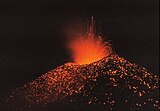Laguna Poco Sol
| Lake Poco Sol | |
|---|---|
| Coordinates | 10°21′N 84°40′W / 10.35°N 84.67°W[1] |
| Type | Crater lake |
| Max. length | 1 km (0.62 mi) |
| Surface area | 1.01 km2 (0.39 sq mi) |
| Max. depth | 11 m (36 ft) |
| Surface elevation | 789 m (2,589 ft) |
Lake Poco Sol (from Spanish, "Little Sunshine"), Laguna Poco Sol or Laguna Pocosol, is a volcanic lake in Costa Rica, in the Cordillera de Tilarán.[2] [3]
The lake lies at an altitude of 789 metres (2,589 ft) in a 200 metres (660 ft) wide depression.[1] The depth of the lake is about 11.5 metres (38 ft).[4]
Other volcanic features in the area include breccia, lahar deposits, lava flows and tuffs. The lake may be a landslide scar, or a crater left by a phreatic explosion. It is of probable Pleistocene age.[1][5] It is constructed within the andesitic Monteverde Formation,[5] which was erupted between 2.1 and 1 million years ago.[4]
Hot springs, mud pots and deposits of sulfur are found both at the lake and near the Río Penas Blancas.[1] The area has been investigated for harnessing geothermal energy. The geothermal activity may be the source of the name Pocosol.[4]
The active volcano Arenal lies north-northwest of Laguna Poco Sol.[5] Arenal along with Cerro Chato between Arenal and Laguna Poco Sol and Cerro Pocosol south of Laguna Poco Sol may be located along a zone of tectonic weakness that was accompanied by northeast-migrating volcanism.[4]
See also
References
- ^ a b c d "Laguna Poco Sol". Global Volcanism Program. Smithsonian Institution.
- ^ Nadkarni, Nalini M.; Wheelwright, Nathaniel T. (2000-03-09). Monteverde: Ecology and Conservation of a Tropical Cloud Forest. Oxford University Press. ISBN 9780199770977.
- ^ "LAGUNA POCO SOL". Retrieved 11 April 2020.
- ^ a b c d Alvarado, Guillermo E. (2008-02-12). "Geología de la Hoja Fortuna, Alajuela, Costa Rica". Revista Geológica de América Central (in Spanish) (41). ISSN 2215-261X.
- ^ a b c Alvarado, Guillermo E. (2009-01-01). "Mapa geológico de la hoja Fortuna". Revista Geológica de América Central (in Spanish). Retrieved 2016-12-16.
- CS1 Spanish-language sources (es)
- Articles with short description
- Short description is different from Wikidata
- Pages using infobox body of water with auto short description
- Coordinates on Wikidata
- Articles using infobox body of water without image
- Articles using infobox body of water without pushpin map alt
- Articles using infobox body of water without image bathymetry
- Articles containing Spanish-language text
- Volcanic crater lakes
- Lakes of Costa Rica
- Pleistocene volcanism
- Volcanoes of Costa Rica

